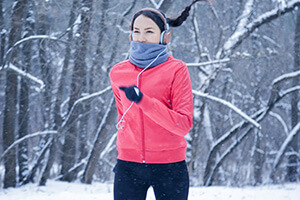When exercise takes your breath away
People with chronic asthma often experience asthma symptoms during exercise, but there are many people without chronic asthma who only develop asthma symptoms during exercise. Exercised-induced asthma is a constricting of the airways in the lungs triggered by exercise.
Exercise-induced asthma symptoms include:
- shortness of breath
- coughing
- wheezing
- fatigue during exercise
- tightness in the chest
- young children may avoid physical activity
Factors that may trigger or increase exercise-induced asthma include:
- Cold air
- Very dry or humid air
- High pollen and/or mold counts
- Air pollution
- Cold or respiratory infection
- Chlorine in swimming pools
- Physical activities that include long periods of deep breathing (swimming, soccer, biking, running)
Contact your health care provider if you experience any symptoms of exercise-induced asthma. While you may still exercise with exercise-induced asthma, your provider will rule out other health conditions and help develop an asthma action plan. Following the plan can help prevent and manage the symptoms and allow you to enjoy physical activity and meet your fitness goals. Asthma-controlling medicine may be prescribed to help lessen inflammation and overreaction of the airways that carry air to the lungs. Some medicines are taken daily and others are taken before or during exercise.
Tips to help prevent and treat exercise-induced asthma:
- If you use a bronchodilator medicine for your asthma, use it before exercising to open up your airways.
- Exercise at your appropriate fitness level.
- Exercise regularly to stay in good physical health.
- Ease in to exercise with slow, warm-up activity for the first 10-15 minutes.
- If exercising in cold weather, wear a face mask or scarf to help moisten the air you breathe in.
- Avoid strenuous exercise if you are fighting a cold or respiratory infection.
- Avoid allergy triggers and exercise indoors when the pollen counts or air pollution are high.
- Breathe through your nose.
- Choose physical activities with shorter bursts of exercise (baseball, volleyball, gymnastics, leisure biking or swimming, walking)
- If your child has exercise-induced asthma, share the asthma action plan with their teachers, nurses and coaches. The plan outlines your child’s treatments, when treatments should be given and what to do if your child experiences symptoms.
